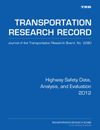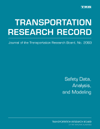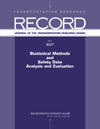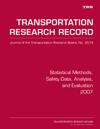|
Papers and Publications by
DiExSys™ |
 Relationship
between Traffic Density, Speed and Safety and Its Implication on Setting
Variable Speed Limits on Freeways Relationship
between Traffic Density, Speed and Safety and Its Implication on Setting
Variable Speed Limits on Freeways |
Speed-flow relationships for a typical basic
freeway segment are well understood at present and are documented by the
successive editions of the Highway Capacity Manual. All recent freeway
studies show that speed on freeways is insensitive to flow in the low to
mid range. Increase in flow and density without reduction in speed has a
significant influence on safety. Constructive discussion of this
influence, however, is largely absent from extant literature. Empirical
examination of the relationship between flow/density, speed and crash
rate on selected freeways in Colorado suggests that as flow/density
increases crash rate initially remains constant until a certain critical
threshold combination of speed and density is reached. Once this
threshold is exceeded the crash rate rapidly rises. The rise in crash
rate may possibly be explained by the fact that compression of flow
without notable reduction in speed produces headways so small that it
becomes very difficult or impossible to compensate for driver’s error to
avoid a crash. In addition to calibrating corridor specific SPFs
relating crash rate to hourly volume/density and speed this paper
proposes a variable speed limit (VSL) algorithm intended to slow traffic
down in real time in advance of a high speed-high density operational
regime. Deployment of such an algorithm has the potential to improve
safety and reduce travel time variability. |
 Relationship
between Freeway Flow Parameters and Safety and Its Implication on Adding
Lanes Relationship
between Freeway Flow Parameters and Safety and Its Implication on Adding
Lanes |
The decision to add lanes to a freeway is motivated by
the need to relieve congestion. Practicing engineers and planners
generally believe that the decreased congestion that results from adding
lanes is associated with some degree of improved safety, yet the
majority opinion of researchers is that accident rates increase as the
number of lanes increases. In more than 70 years of modern road
building, these conflicting views have not been reconciled. This paper
first examines the relationship of traffic flow parameters, such as
volume, density, and speed, with safety by calibrating corridor-specific
safety performance functions. On the basis of an understanding of this
relationship, a possible explanation of the effect that adding lanes has
on safety is formulated. An empirical examination of the relationship of
flow, density, and speed to the crash rate on selected freeways in
Colorado suggests that, as the flow increases, the crash rate initially
remains constant until a certain critical threshold combination of speed
and density is reached. Once this threshold is exceeded, the crash rate
rapidly rises. The rise in the crash rate may be because an increase in
density without a notable reduction in speed produces headways so small
that it becomes difficult or impossible to compensate for driver error.
This model suggests that, after the construction of additional lanes,
crash rates initially decline because of the lower traffic volume and
density per lane. However, as development and rerouting occur, freeways
with more lanes are expected to have higher crash rates that are
attributable to the increased opportunities for lane change–related
conflicts. |
 Relationship
between Freeway Flow Parameters and Safety and its Implications on Hard
Shoulder Running Relationship
between Freeway Flow Parameters and Safety and its Implications on Hard
Shoulder Running |
Decisions to run traffic on freeway
shoulders during peak period are motivated by the need to relieve
congestion. It is generally believed by practicing traffic engineers
that decreased congestion resulting from hard shoulder running is
associated with some unspecified degree of improved safety, yet the
majority opinion among researchers is that accident rates increase with
increase in the number of lanes even if full shoulders are provided.
Despite many years of modern road building these conflicting views have
not been reconciled. This paper first examines the relationship of
traffic flow parameters such as volume, density, and speed to safety by
calibrating corridor specific safety performance functions. On the basis
of understanding this relationship a possible explanation of the effect
of hard shoulder running on safety is formulated. Empirical examination
of the relationship of flow, density, and speed to the crash rate on
selected freeways in Colorado suggests that, as flow increases crash
rate initially remains constant until a certain critical threshold
combination of speed and density is reached. Once this threshold is
exceeded, the crash rate rapidly rises. The rise in crash rate may
possibly be explained by the fact that increase in density without
notable reduction in speed produces headways so small that it becomes
very difficult or impossible to compensate for driver’s error. This
model suggests that during hard shoulder running crash rates decline
because of lower traffic volume/density per lane. It also suggests that
safety benefits of reducing volume or density per lane outweigh adverse
effects of not providing a full shoulder. |
 Relating
Flow, Speed, and Density of Urban Freeways to Functional Form of a
Safety Performance Function Relating
Flow, Speed, and Density of Urban Freeways to Functional Form of a
Safety Performance Function
2011 Paper of the Year Award |
Constructive discussion of the appropriate
choice for the functional form of safety performance functions (SPFs) is
generally absent from research literature on road safety. Among
researchers who develop SPFs, there appears to be a consensus that the
underlying randomness in accident counts is well described by the
negative binomial (NB) distribution. The underlying phenomenon itself,
however, is not well understood and is rarely discussed. The choice of
the regression equation is usually not explained or documented.
Researchers most commonly use the power function, possibly because most
generalized linear modeling (GLM) statistical packages can accommodate
the power function with little effort. The modeling process, however
statistically rigorous, at times seems disconnected from the physical
phenomenon that it is trying to describe. The disconnect, however, has
attracted only limited interest from researchers to date. Accidents on
an urban freeway are a by-product of traffic flow; therefore, changes in
the flow parameters may give clues about the probability of accident
occurrence and changes in accident frequency. This study related traffic
flow parameters, such as speed and density, to the choice of the
functional form of the SPF. It compared SPF models for urban freeways
developed with sigmoid and exponential functional forms with the use of
data from Colorado and California and contrasted the cumulative residual
(CURE) plots of the models. SPFs developed around a sigmoid functional
form through the use of neural network (NN) methodology suggested
underlying relationships between safety and traffic flow
characteristics. CURE plots for NN-generated SPFs generally showed a
better-quality model fit when compared with power-function SPFs, which
were developed in the GLM framework with an NB error structure. |
 Relationships
Between Safety and Both Congestion and Number of Lanes on Urban Freeways Relationships
Between Safety and Both Congestion and Number of Lanes on Urban Freeways |
This paper first explores the relationship
between safety and congestion and then examines the relationship between
safety and the number of lanes on urban freeways. The relationship
between safety and congestion on urban freeways was explored using
Safety Performance Functions (SPF) calibrated for multilane freeways in
Colorado, California and Texas. The focus of most SPF modeling efforts
to date has been on the statistical technique and the underlying
probability distribution with only a limited consideration given to the
nature of the phenomenon itself. In this study Neural Networks have been
used to identify the underlying relationship between safety and
exposure. The modeling process was informed by the consideration of the
traffic operations parameters described by the Highway Capacity Manual (HCM).
The shape of the SPF is best described by a sigmoid reflecting
dose-response-like relationship between safety and traffic demand on
urban freeways. Relating safety to the degree of congestion suggests
that safety deteriorates with the degradation in the quality of service
expressed in terms of the Level of Service (LOS). It is generally
believed by the practitioners that additional capacity afforded by
additional lanes is associated with more safety. How much safety and for
what time period is generally not considered. Comparison of the Safety
Performance Functions (SPF) of multilane freeways suggests that adding
lanes may initially result in a temporary safety improvement that
disappears as congestion increases. As Annual Average Daily Traffic (AADT)
increases, the slope of SPF, described by its first derivative, becomes
steeper, reflecting that accidents are increasing at a faster rate than
would be expected from a freeway with fewer lanes. |
 Level
of Service of Safety Conceptual Blueprint and Analytical Framework Level
of Service of Safety Conceptual Blueprint and Analytical Framework |
While some initial and significant progress has been made
in the development of a highway safety manual, much remains to be done
in the areas of conceptual development and the diagnostics of safety
problems. The concept of level of service of safety (LOSS) in the
framework of safety performance function is introduced, and the problem
of diagnostics is addressed. LOSS reflects how the roadway segment is
performing in regard to its expected accident frequency and severity at
a specific level of annual average daily traffic. It provides a
comparison of accident frequency and severity only with the expected
norms; it does not, however, provide any information related to the
nature of the safety problem itself. If the safety problem is present,
LOSS will describe only its magnitude. The nature of the problem is
determined through diagnostic analysis by direct diagnostics and pattern
recognition techniques, which are also discussed. |
 Explicit
Consideration of Safety in Transportation Planning and Project Scoping Explicit
Consideration of Safety in Transportation Planning and Project Scoping |
The Transportation Equity Act for the 21st Century of
1998 required explicit consideration of safety in the transportation
planning process. Although this government mandate is well intentioned,
little is known about how to accomplish it. Despite 60 years of modern
road building, there is still no consensus among transportation
professionals about how to quantify the degree of safety or lack of
safety of an existing transportation facility. It is even more difficult
to anticipate the level of safety on highways not yet built. A
methodology for the explicit consideration of safety in the
transportation planning process is presented, followed by a review of
two case histories illustrating its application. |
 How
Best to Rank Sites with Promise How
Best to Rank Sites with Promise |
The starting point for a program of local safety
improvements is the preparation of a list of sites with promise at which
to conduct a detailed engineering study, by which cost-effective
projects can be identified. Inclusion on the list depends on the
criteria used for ranking sites. Five alternative ranking criteria were
compared by the cost-effectiveness of the projects to which they lead.
It was found that sites at which most accidents or most severity-weighed
accidents are expected lead to most cost-effective projects. |
 Identifying
Locations with Potential for Accident Reductions Use of Direct
Diagnostics and Pattern Recognition Methodologies Identifying
Locations with Potential for Accident Reductions Use of Direct
Diagnostics and Pattern Recognition Methodologies
|
Safety performance functions reflect the complex
relationship between exposure, usually measured in annual average daily
traffic, and accident count for a unit of road section over a unit of
time. One of the main uses of the safety performance functions is to
identify locations that experience more accidents than expected, thus
exhibiting a potential for accident reduction. Overrepresentation in the
number of accidents above the expected or normal threshold predicted by
the safety performance function is only one of many indicators of a
potential for accident reduction. Accident type, severity, road
condition, spatial distribution of accidents, and lighting conditions
are only a few of the many important symptoms of the accident problem.
Two methodologies are introduced for identification of locations with
potential for accident reduction: direct diagnostics and continuous
pattern recognition analysis. Use of these methodologies revealed that
existence of accident patterns susceptible to correction may or may not
be accompanied by the overrepresentation in accident frequency detected
by the safety performance functions. |
 Diagnostic
Methodology for the Detection of Safety Problems at Intersections Diagnostic
Methodology for the Detection of Safety Problems at Intersections
|
There is an established consensus among traffic safety
researchers that a nonlinear relationship exists between traffic
exposure and safety. This relationship is reflected by the safety
performance functions (SPFs) calibrated for various classes of roads and
intersections. One of the main uses of SPFs is to identify locations
with potential for accident reduction. While this application is
certainly important, the use of SPFs provides no information related to
the nature of the accident occurrence. Without being able to relate
accident frequency and severity to roadway geometrics, traffic control
devices, roadside features, roadway condition, driver behavior, or
vehicle type, it is not possible to develop effective countermeasures. A
methodology was developed to provide guidance in diagnostics of safety
problems, recognition of accident patterns, and development of
appropriate countermeasures. Considering that traffic accidents can be
viewed as random Bernoulli trials, it is possible to detect deviation
from the statistical process by computing observed cumulative
probability for each of the accident characteristics. Detection of an
accident pattern at an intersection suggests the presence of an element
in the roadway environment that triggered a deviation from a random
statistical process in the direction of reduced safety. Identification
of such an element always provides a critical clue to accident
causality. |
 Screening
the Road Network for Sites with Promise Screening
the Road Network for Sites with Promise
|
Network screening is the first step in
the site safety improvement process. The product of network screening is
a list of sites that are ranked by priority for the conduct of detailed
engineering studies. In turn, cost effective projects are formulated
from the studies. With the purpose of laying the foundation for improved
network screening, the role of network screening is clarified, and how
project cost and safety benefit can be anticipated at the time of
screening is examined. The strengths and weaknesses of alternative
assumptions on which the anticipation of safety benefit can be based are
discussed. A way to guard against misallocation of resources due to the
randomness of accident counts is suggested, and a method for finding
peak sites within road sections is proposed. |
 Risk
Analysis of Freeway Lane Closure During Peak Hour Risk
Analysis of Freeway Lane Closure During Peak Hour |
This paper examines risks associated with
peak period lane closure during construction or maintenance work on
urban freeways. In accordance with recently implemented policy by the
Colorado Department of Transportation, lane closure would be allowed if
reserve capacity were available. A relatively minor accident in the work
zone caused substantial delays during the peak period that virtually
paralyzed traffic in the Denver, Colorado, metropolitan area. This
occurrence caused reexamination of the existing lane closure policy.
Generally speaking, if a contractor is allowed greater flexibility in
establishing work schedules, including the ability to work through peak
periods, a lower bid can be expected. This paper compares savings in the
cost of construction related to allowing lane closure during peak
periods with the cost of potential incident-related delays in the
framework of a quantitative risk analysis. |
|
Exploratory
Analysis of Relationship between the Number of Lanes and Safety on Urban
Freeways Accepted for
Presentation at 2008 TRB Annual Meeting |
The relationship between freeway capacity
and the number of lanes is reasonably well understood at present. In
contrast to capacity, the relationship between the number of lanes and
safety is not fully understood or systematically considered when
planning capacity improvements. During the planning and design phase the
discussion is centered on the degree to which design alternatives comply
with geometric design standards and what Level of Service (LOS) is
provided. It is generally believed by the practitioners that additional
capacity afforded by additional lanes is associated with more safety.
How much safety and for what time period is generally not considered.
Exploratory analysis of the Safety Performance Functions (SPF) for
multilane freeways in Colorado, California and Texas suggests that
adding lanes may initially result in a temporary safety improvement that
disappears as congestion increases. As Annual Average Daily Traffic
(AADT) increases, the slope of SPF, described by its first derivative,
becomes steeper, reflecting that accidents are increasing at a faster
rate than would be expected from a freeway with fewer lanes. This may
possibly be explained by the fact that increase in the number of lanes
is associated with increase in the number of potential
lane-change-related conflict opportunities. Understanding of the
relationship between number of lanes and safety should be used to inform
the public involvement process in evaluating and selecting design
alternatives. Additionally, high AADT on multilane freeways is
associated with high crash frequency and consequently reduced mobility. |
|
Exploratory
Examination of the Functional Form of Safety Performance Functions of
Urban Freeways Accepted for
Presentation at 2008 TRB Annual Meeting |
Safety Performance Functions are accident
prediction models that relate traffic exposure, measured in Annual
Average Daily Traffic (AADT) to safety, measured in the annual number of
accidents per mile (accidents/mile per year). Review of literature on
the development of Safety Performance Functions (SPF) suggests that the
focus of most modeling efforts is on the statistical technique and the
underlying probability distribution with only a limited consideration
given to the nature of the phenomenon itself. In this study Neural
Networks have been used to identify the underlying relationship between
safety and exposure. The modeling process was informed by the
consideration of the traffic operations parameters described by the
Highway Capacity Manual (HCM). The shape of the SPF is best described by
a sigmoid reflecting dose response - like relationship between safety
and traffic demand on urban freeways. We observed that on un-congested
segments the number of crashes increases only moderately with increase
in traffic; however, once some critical traffic density is reached, the
number of crashes begins to increase at a much faster rate with increase
in traffic. This phenomenon is reflected by a steeper gradient of the
SPF. Further examination of the SPF suggests that on segments with high
AADT (LOS-F during peak period), the function begins to level off,
reflecting decrease in accident rates related to a high degree of
congestion and significant reduction in operating speeds. Relating
safety to the degree of congestion suggests that safety deteriorates
with the degradation in the quality of service expressed in terms of the
Level of Service (LOS). |
 Safety
Planning Study of an Urban Freeway - Proposed Methodology and Review of
the Case History Safety
Planning Study of an Urban Freeway - Proposed Methodology and Review of
the Case History |
Safety-conscious planning is a relatively
new concept. It was developed in response to safety related provisions
of the Transportation Equity Act for the 21st Century (TEA-21) of 1998
that required explicit consideration of safety in the transportation
planning process. This paper will revisit the problem of using accident
rates in transportation planning and review a case history of applying
safety-conscious planning methods by the Colorado Department of
Transportation (CDOT). A two-phase process that has been used to
evaluate the safety impacts of multiple design alternatives is
introduced. The evaluation process is based on the available Safety
Performance Functions calibrated specifically for urban freeways in
concert with diagnostic investigations, pattern recognition analysis and
detailed accident diagramming. The critical importance of accident
diagramming is discussed in reference to examining safety history at
complex interchange locations. |

 Relationship
between Traffic Density, Speed and Safety and Its Implication on Setting
Variable Speed Limits on Freeways
Relationship
between Traffic Density, Speed and Safety and Its Implication on Setting
Variable Speed Limits on Freeways Relationship
between Freeway Flow Parameters and Safety and Its Implication on Adding
Lanes
Relationship
between Freeway Flow Parameters and Safety and Its Implication on Adding
Lanes Relating
Flow, Speed, and Density of Urban Freeways to Functional Form of a
Safety Performance Function
Relating
Flow, Speed, and Density of Urban Freeways to Functional Form of a
Safety Performance Function Relationships
Between Safety and Both Congestion and Number of Lanes on Urban Freeways
Relationships
Between Safety and Both Congestion and Number of Lanes on Urban Freeways Level
of Service of Safety Conceptual Blueprint and Analytical Framework
Level
of Service of Safety Conceptual Blueprint and Analytical Framework Explicit
Consideration of Safety in Transportation Planning and Project Scoping
Explicit
Consideration of Safety in Transportation Planning and Project Scoping Identifying
Locations with Potential for Accident Reductions Use of Direct
Diagnostics and Pattern Recognition Methodologies
Identifying
Locations with Potential for Accident Reductions Use of Direct
Diagnostics and Pattern Recognition Methodologies Risk
Analysis of Freeway Lane Closure During Peak Hour
Risk
Analysis of Freeway Lane Closure During Peak Hour Safety
Planning Study of an Urban Freeway - Proposed Methodology and Review of
the Case History
Safety
Planning Study of an Urban Freeway - Proposed Methodology and Review of
the Case History